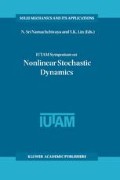Abstract
An important problem in semiactive control of structures using “smart” damping devices for vibration mitigation is the development of an efficient control algorithm which accounts for the dissipative characteristics of the device. For smart dampers, the dissipative nature can be represented by a nonlinear inequality constraint that cannot be directly imposed on optimal control strategies using standard techniques. In previous research, the authors introduced a method using linear matrix inequality (LMI) methods to include a dissipativity constraint in a linear quadratic regulator (LQR) problem for semiactive control of structures. In this method, the LQR problem is defined as an eigenvalue problem (EVP) in terms of LMIs. Then, the dissipativity constraint is appended to the EVP in its weak expected value form. In this paper, this method is applied to realistic building and damper models. The structure is chosen to be a 9-story benchmark building and a recently-developed 20-ton magnetorheological (MR) fluid damper model as the control devices. It is found that the proposed method provides a more efficient controller, with reduced force levels and almost the same performance compared to a conventional LQR approach.
Access this chapter
Tax calculation will be finalised at checkout
Purchases are for personal use only
Preview
Unable to display preview. Download preview PDF.
References
G. E. Dullerud and F Paganini, A Course in Robust Control Theory: A Convex Approach, Springer, New York, 2000.
S. J. Dyke, B. F. Spencer, Jr., M. K. Sam, and J. D. Carison, “Modeling and Control of Magnetorheological Dampers for Seismic Response Reduction,” Smart Materials & Struct., vol. 5, pp. 565–575, 1996.
H. Fujitani, H. Sodeyama, K. Hata, N. Iwata, Y. Komatsu, K. Sunakoda, and S. Soda, “Dynamic Performance Evaluation of Magnetorheological Damper:” Proceedings of International Conference on Advances in Structural Dynamics, Hong Kong, China, vol. 1, pp. 319–326, 2000.
E. A. Johnson. “Nonlinear Seismic Benchmark Problem: Dissipativity and the 9-Story Benchmark Building. ” 2nd European Conf Struct. Ctrl, France, July 3–6, 2000.
E. A. Johnson, G. A. Baker, B. F Spencer, Jr., and F Fujino, “Semiactive Damping of Stay Cables,” Journal of Engineering Mechanics, ASCE, 2003, in press.
E. A. Johnson and B. Erkus, “Structural Control with Dissipative Damping Devices,” 2002 American Control Conference (ACC02), Anchorage, Alaska, May 8–10, 2002. Proceedings, pp. 2463-2468. CD-ROM Proceedings, paper ACC02-2463, file 441. pdf
Y. Ohtori, R. E. Christenson, B. F. Spencer, Jr., and S. J. Dyke, “Benchmark Control Problems for Seismically Excited Nonlinear Buildings,” Proceedings of the 2nd European Conference on Structural Control, 2000. An extended version of this paper is on web at http://www.nd.edu/quake/papers/NLbench.pdf
J. C. Ramallo, E. A. Johnson, and B. F. Spencer, Jr., “Smart’ Base Isolation Systems,” Journal of Engineering Mechanics, ASCE, vol. 128, no. 10, pp. 1088–1099, 2002.
T. T. Soong and M. Grigoriu, “Random Vibration of Mechanical and Structural Systems,” Prentice Hall, Englewood, Cliffs, NJ, 1993.
B. F Spencer, Jr. and M. K. Sam, “Controlling Buildings: A New Frontier in Feedback,” IEEE Control Systems Mag., vol. 17, no. 6, pp. 19–35, 1997.
R. F. Stengel, Optimal Control and Estimation, Dover Publications, New York, 1994.
G. Yang, B. F. Spencer, Jr., J. D. Carlson, and M. K. Sam, “Large-Scale MR Fluid Dampers: Modeling and Dynamic Performance Considerations,” Engineering Structures, vol. 24, pp. 309–327, 2002.
Author information
Authors and Affiliations
Editor information
Editors and Affiliations
Rights and permissions
Copyright information
© 2003 Springer Science+Business Media Dordrecht
About this paper
Cite this paper
Johnson, E.A., Erkus, B. (2003). Structural Vibration Mitigation Using Dissipative Smart Damping Devices. In: Namachchivaya, N.S., Lin, Y.K. (eds) IUTAM Symposium on Nonlinear Stochastic Dynamics. Solid Mechanics and Its Applications, vol 110. Springer, Dordrecht. https://doi.org/10.1007/978-94-010-0179-3_19
Download citation
DOI: https://doi.org/10.1007/978-94-010-0179-3_19
Publisher Name: Springer, Dordrecht
Print ISBN: 978-94-010-3985-7
Online ISBN: 978-94-010-0179-3
eBook Packages: Springer Book Archive

